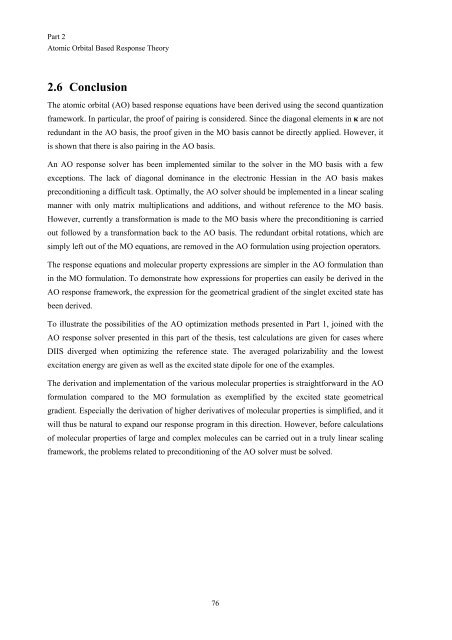Get my PhD Thesis
Get my PhD Thesis
Get my PhD Thesis
You also want an ePaper? Increase the reach of your titles
YUMPU automatically turns print PDFs into web optimized ePapers that Google loves.
Part 2<br />
Atomic Orbital Based Response Theory<br />
2.6 Conclusion<br />
The atomic orbital (AO) based response equations have been derived using the second quantization<br />
framework. In particular, the proof of pairing is considered. Since the diagonal elements in κ are not<br />
redundant in the AO basis, the proof given in the MO basis cannot be directly applied. However, it<br />
is shown that there is also pairing in the AO basis.<br />
An AO response solver has been implemented similar to the solver in the MO basis with a few<br />
exceptions. The lack of diagonal dominance in the electronic Hessian in the AO basis makes<br />
preconditioning a difficult task. Optimally, the AO solver should be implemented in a linear scaling<br />
manner with only matrix multiplications and additions, and without reference to the MO basis.<br />
However, currently a transformation is made to the MO basis where the preconditioning is carried<br />
out followed by a transformation back to the AO basis. The redundant orbital rotations, which are<br />
simply left out of the MO equations, are removed in the AO formulation using projection operators.<br />
The response equations and molecular property expressions are simpler in the AO formulation than<br />
in the MO formulation. To demonstrate how expressions for properties can easily be derived in the<br />
AO response framework, the expression for the geometrical gradient of the singlet excited state has<br />
been derived.<br />
To illustrate the possibilities of the AO optimization methods presented in Part 1, joined with the<br />
AO response solver presented in this part of the thesis, test calculations are given for cases where<br />
DIIS diverged when optimizing the reference state. The averaged polarizability and the lowest<br />
excitation energy are given as well as the excited state dipole for one of the examples.<br />
The derivation and implementation of the various molecular properties is straightforward in the AO<br />
formulation compared to the MO formulation as exemplified by the excited state geometrical<br />
gradient. Especially the derivation of higher derivatives of molecular properties is simplified, and it<br />
will thus be natural to expand our response program in this direction. However, before calculations<br />
of molecular properties of large and complex molecules can be carried out in a truly linear scaling<br />
framework, the problems related to preconditioning of the AO solver must be solved.<br />
76

















